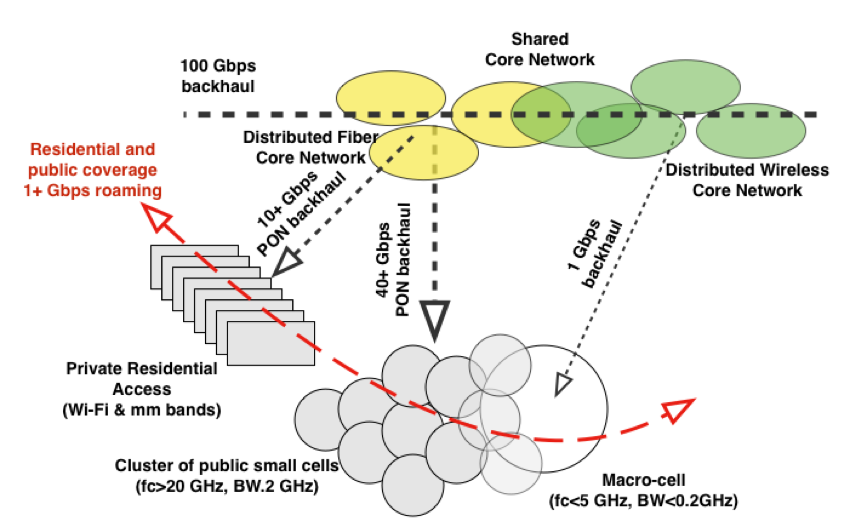Wireless
Propagation, Performance and the Promise of Fixed Wireless Access
Key Points
- Fixed wireless access (FWA) presents a cost-effective solution for operators seeking to expand their footprint, especially in residential, enterprise and indoor environments.
- While propagation challenges exist, they can be mitigated with scenario-specific optimizations.
Fixed wireless access (FWA) is a mature access technology that could provide cost-effective solutions for both mobile network operators (MNOs) and multiple system operators (MSOs). It enables MNOs to provide fixed cable-like services and MSOs to increase speed and capacity while extending HFC services beyond their current footprints.
CableLabs recently analyzed how key propagation parameters impact FWA performance. Our findings indicate that while FWA propagation can be challenging, it is scenario dependent. Factors such as user throughput targets, antenna design/selection and MIMO channel capacity can play significant roles. The analysis also highlights some opportunities for operators to mitigate the propagation challenges.
We detailed these findings in two new SCTE papers: “Fixed Wireless Access Propagation Challenges” and “Experimental FWA MIMO Capacity Analysis in 6 and 37 GHz Bands.” We explored our insights further during our session at SCTE TechExpo24, which is now available to watch on-demand.
Together, these publications, along with related papers, analyze the FWA propagation-related challenges for North American residential and indoor office environments and summarize our latest research on FWA.
Our investigation was based on experimental results provided by four extensive indoor and outdoor-to-indoor (O2I) test campaigns, followed by a thorough data analysis and statistical model development.
Customer premises equipment (CPE) in a FWA network can use either an outdoor or an indoor antenna. While the outdoor antenna offers better technical performance, the indoor option is more cost-effective due to minimal installation costs.
Fixed Wireless Access Testing
When using 5G support, the FWA performance is augmented by the associated large channel bandwidth (ChBW), e.g., up to 100MHz for sub 7GHz spectra and up to 400MHz for millimeter (mmWave, 24 - 52 GHz), accordingly increasing user throughput.
CableLabs analyzed the propagation impact upon FWA performance in both indoor and outdoor-to-indoor (O2I) scenarios in the 6 GHz and 37 GHz bands. The studies are grouped into two categories:
- Single-input multiple-output (SIMO) propagation challenges (path loss, O2I loss, power delay and angular profiles, delay and angular spread, angle of arrival, synthetic beamwidth, Small-scale fading Rician K-factor)
- Multiple-input multiple-output (MIMO) channel capacity gain
To evaluate the FWA network performance and impact from the propagation channel, multiple test campaigns were designed to characterize the path loss, building entry loss (BEL), large-scale fading (e.g., shadowing), small-scale fading impact (e.g., changing the receiver position by a few lambdas). We selected the test environments accordingly:
- An indoor office environment (CableLabs’ main office in Louisville, Colorado -- 2nd floor), providing 172 links (86 for each 6 and 37GHz band)
- O2I residential environment (the CableLabs Test House in Brighton, Colorado), providing 216 links (108 for each 6 and 37GHz band), in LOS, NLOS, deep NLOS and through vegetation (trees) propagation
The test setup was based on a virtual circular array (VCA), featuring the equivalent of 1,000 antenna elements. For each antenna position on the VCA, measurements included the channel transfer functions (CTFs), channel impulse responses (CIRs), path loss, etc. Using such a VCA avoided a need to re-align the CPE antenna for each measurement and the small-scale fading impact.
Propagation Impairments
Our indoor and O2I measurement results support a direct comparison of the propagation impact upon the indoor and O2I FWA indoor performance for the 6 and 37 GHz cases.
A high-level comparison of the measured FWA O2I path losses indicates that there is a 15-20 dB link budget penalty when 37 GHz links are used vs. similar 6 GHz links for the same type of environment. The 37 GHz O2I penalty is partially compensated by the reduced number of multipath components (MPCs), caused by the rapid Rx power decay of the 37 GHz MPC in the O2I and indoor FWA environments. Intuitively, the latter suggests that 37 GHz FWA O2I/indoor links could provide a better performance (SNR/User Throughput) vs. sub 7GHz bands if the related link budget penalty could be compensated.
MIMO Channel Capacity Gain
The MIMO channel capacity gain represents the ratio of the MIMO vs. SISO channel capacity. The MIMO channel capacity gain is identical to the MIMO user throughput gain (the ratio of the MIMO user throughput vs. SISO user throughput). For a MIMO 2×2 link, the ideal MIMO capacity gain/user throughput is equal to two. Our findings indicate that the MIMO capacity gain and the MIMO user throughput gain is degraded due to the propagation in a FWA scenario.
Our SCTE paper and presentation provide more details on the causes of the MIMO user throughput gain being higher in NLOS than LOS conditions and on MIMO user throughput gain impacted by antenna separation distance and orientation, etc.
Future Opportunities
Despite the propagation-related challenges — particularly in North American residential and indoor office environments — FWA O2I presents a viable solution for operators seeking to expand their service footprint. To learn more, download the SCTE papers, “Fixed Wireless Access Propagation Challenges” and “Experimental FWA MIMO Capacity Analysis in 6 and 37 GHz Bands,” and watch our TechExpo presentation.
Wireless
Non-traditional Stakeholders in 5G Network Developments

With the growth of mobile data consumption, the mobile industry is embarking on its next evolution of technology, dubbed 5G referring to fifth generation mobile networks. The global wireless community has high expectations from 5G networks in terms of end user experience. Goals include achieving lower latencies and increased capacities by at least one order of magnitude in addition to radically new use cases for the technology.
3GPP, the standard development organization (SDO) that drives mobile wireless standards development, has been leading global efforts for the first four generations of wireless networks. The developments in 3GPP have focused on addressing the requirements of mobile networks who have been the primary beneficiaries of these technology evolutions.
CableLabs Participates in 3GPP Discussions
CableLabs has been actively involved with 3GPP because 5G networks will require tighter integration between fixed and mobile networks. The cable industry will play a role in the success of 5G network deployments.
More than half of the global vendors, mobile network operators and research entities who contributed to the 3GPP RAN 5G Workshop in September 2015 indicated that an efficient M2M/IOT support, coexisting with other forms of high capacity traffic, are expected to be a major use case for 5G networks. Specifically, CableLabs’ contribution to the this meeting outlined a “one user, one network” paradigm which allows the user to seamlessly roam between the fixed/pedestrian home/office environment and outdoor mobile environments. Additionally, it is crucial that the cable industry be involved, given the criticality of 10+ Gbps backhaul support of 5G.
Examples of M2M/IoT use cases that are expected to bring non-traditional players to the 5G development table span:
- Small appliances vendors
- Local, provincial and federal/national governments, employing different security, traffic and city wide monitoring operations
- Car manufacturers
- Utilities (water, hydro, gas)
- Industries employing sensor nodes on a large scale (energy, chemical etc)
The vast majority of the participants expected that the spectrum expansion into millimetric wave-bands is expected to be the main focus of 5G development.
The Advantages of 5G
In addition to the large bandwidths (1-4 GHz) made available in the new FCC allocated cm/mm spectra, 5G networks are expected to make effective use of large hybrid beam-forming / MIMO technologies, new modulations and coding schemes. Harnessing these technologies will allow the 5G base stations to transmit in multiple Gbps. This level of performance will require significant backhaul capabilities. For example, technologies like Coordinated MultiPoint can optimize the inter-cell interference at the cell edge and improve a user’s throughput. In return, such an implementation would require the backhaul/fronthaul to carry 10+ Gbps of data, at very low latency.
The cable industry, with its deep fiber and HFC networks capable of supporting large capacities, is well positioned to leverage 5G technologies and drive a new level of mobile experience. In return for the “one user, one network” environment, requirements might include:
- A re-usable access network (between the fixed and wireless networks)
- A distributed core network capability such as the example shown in Figure (1).

Figure 1. Example of a distributed core network architecture backed by a re-usable access network.
All of the above point to the fact that 5G networks will require multiple stake-holders closely collaborating to deliver the targeted promises of 5G. This collaboration could be across various areas such as the convergence of fixed and wireless networks, and efficient support of M2M/IOT use cases.
Based on the above, for 5G networks to be able to deliver the targeted requirements across various industries, it is reasonable to expect changes in the technology development landscape of 5G in comparison to previous generations of mobile wireless standards. Traditional mobile industry players will need to work hand in hand with non-traditional players in the development of 5G networks’ technologies and standards. For these reasons, CableLabs is contributing to the ongoing formation of 5G network architectures.
Attend our Inform[ED] Wireless Conference to Learn More
We will be continuing the discussion of the role that the cable industry will play in 5G networks’ future at our Inform[ED] Wireless Conference in New York City on April 13.
Dorin Viorel is a Principal Wireless Architect at CableLabs.
Belal Hamzeh, VP of Wireless Technologies, CableLabs, also contributed to this article.

